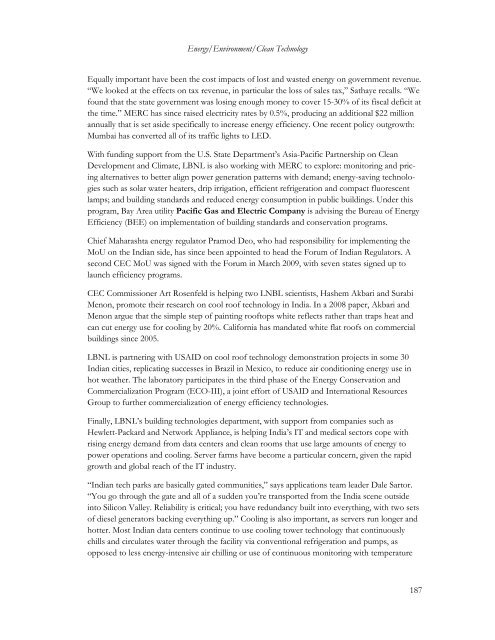PDF: 2962 pages, 5.2 MB - Bay Area Council Economic Institute
PDF: 2962 pages, 5.2 MB - Bay Area Council Economic Institute
PDF: 2962 pages, 5.2 MB - Bay Area Council Economic Institute
You also want an ePaper? Increase the reach of your titles
YUMPU automatically turns print PDFs into web optimized ePapers that Google loves.
Energy/Environment/Clean Technology<br />
Equally important have been the cost impacts of lost and wasted energy on government revenue.<br />
“We looked at the effects on tax revenue, in particular the loss of sales tax,” Sathaye recalls. “We<br />
found that the state government was losing enough money to cover 15-30% of its fiscal deficit at<br />
the time.” MERC has since raised electricity rates by 0.5%, producing an additional $22 million<br />
annually that is set aside specifically to increase energy efficiency. One recent policy outgrowth:<br />
Mumbai has converted all of its traffic lights to LED.<br />
With funding support from the U.S. State Department’s Asia-Pacific Partnership on Clean<br />
Development and Climate, LBNL is also working with MERC to explore: monitoring and pricing<br />
alternatives to better align power generation patterns with demand; energy-saving technologies<br />
such as solar water heaters, drip irrigation, efficient refrigeration and compact fluorescent<br />
lamps; and building standards and reduced energy consumption in public buildings. Under this<br />
program, <strong>Bay</strong> <strong>Area</strong> utility Pacific Gas and Electric Company is advising the Bureau of Energy<br />
Efficiency (BEE) on implementation of building standards and conservation programs.<br />
Chief Maharashta energy regulator Pramod Deo, who had responsibility for implementing the<br />
MoU on the Indian side, has since been appointed to head the Forum of Indian Regulators. A<br />
second CEC MoU was signed with the Forum in March 2009, with seven states signed up to<br />
launch efficiency programs.<br />
CEC Commissioner Art Rosenfeld is helping two LNBL scientists, Hashem Akbari and Surabi<br />
Menon, promote their research on cool roof technology in India. In a 2008 paper, Akbari and<br />
Menon argue that the simple step of painting rooftops white reflects rather than traps heat and<br />
can cut energy use for cooling by 20%. California has mandated white flat roofs on commercial<br />
buildings since 2005.<br />
LBNL is partnering with USAID on cool roof technology demonstration projects in some 30<br />
Indian cities, replicating successes in Brazil in Mexico, to reduce air conditioning energy use in<br />
hot weather. The laboratory participates in the third phase of the Energy Conservation and<br />
Commercialization Program (ECO-III), a joint effort of USAID and International Resources<br />
Group to further commercialization of energy efficiency technologies.<br />
Finally, LBNL’s building technologies department, with support from companies such as<br />
Hewlett-Packard and Network Appliance, is helping India’s IT and medical sectors cope with<br />
rising energy demand from data centers and clean rooms that use large amounts of energy to<br />
power operations and cooling. Server farms have become a particular concern, given the rapid<br />
growth and global reach of the IT industry.<br />
“Indian tech parks are basically gated communities,” says applications team leader Dale Sartor.<br />
“You go through the gate and all of a sudden you’re transported from the India scene outside<br />
into Silicon Valley. Reliability is critical; you have redundancy built into everything, with two sets<br />
of diesel generators backing everything up.” Cooling is also important, as servers run longer and<br />
hotter. Most Indian data centers continue to use cooling tower technology that continuously<br />
chills and circulates water through the facility via conventional refrigeration and pumps, as<br />
opposed to less energy-intensive air chilling or use of continuous monitoring with temperature<br />
187








